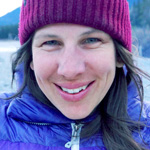Last summer, I spent time in British Columbia’s Flathead Valley, an area known as one of the grizzliest places in North America. This vast, wild expanse of forests, wildflower-lined creeks and gravel river floodplains is the last unsettled river valley in southern Canada. Here, across 1,600 square kilometres, grizzlies have the space they need to find food, mates and shelter.
Standing in this startlingly beautiful landscape, I felt the deepest sense of connection to it. For me, the Flathead is a reminder of what’s at stake. Wild places like this used to be found all across North America. In the Rocky and Columbia Mountains, we are lucky to still have enough wild, connected spaces to support grizzly bears and other large animals. But unless people like you and I defend them, they too will be lost.

Why connection matters
Logging, mining and roads are fragmenting this precious region and putting species like grizzlies at risk. Just as you and I need connection to the wild to thrive, grizzlies need connection too — it’s integral to their ability to survive as a species and to adapt to threats like wildfires, food shortages and drought. Many grizzly populations in the Rockies, Purcells and Selkirks are highly or totally isolated. By creating new connected and protected areas, we can safeguard their future and that of many other wild animals for generations to come.
Together, we’ve already made so much progress protecting and connecting wild habitat and landscapes. We’ve successfully deferred logging in critical wildlife corridors. We’ve helped create wildlife underpasses so bears can cross the highway without risking their lives. And we’ve supported our First Nations partners to protect some of this region’s most culturally and ecologically significant land. But we can do more.
A unique opportunity for change
I have one of the most wonderful jobs in the world: I get to go behind the scenes, into the halls of power, to take part in the conversations that precede real wins for the wild. These are conversations that lead to new permanently protected areas, like parks and Indigenous Protected and Conserved Areas.
Together, we are making our voices heard in these conversations. More and more, our governments are realizing that wild places do have a value beyond what can be extracted from them — that their protection is intrinsic to the preservation of Indigenous culture, wildlife and our own quality of life.
Last month, Canada and British Columbia made historic conservation funding commitments worth over $1 billion. Never before have we had such a unique opportunity to create new protected areas that will safeguard species like grizzly bears for generations to come. Now, it’s up to us to ensure our leaders turn their promises into action.
Will you join me in defending our wild places so that future generations of grizzly bears have room to roam safely, to connect and to thrive? Will you donate today to protect grizzly bears and the wild places they call home?
For the wild,


Robyn Duncan,
Wildsight Executive Director
p.s. Giving monthly is the most effective way to take action for the wild. Consider becoming a monthly donor today, and fight for wildlife and wild places all year round.








